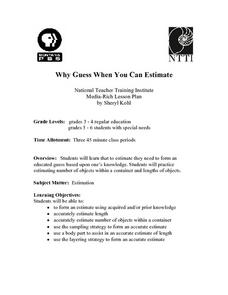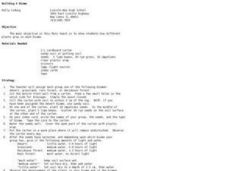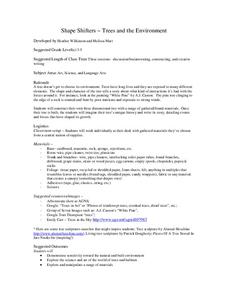Curated OER
Brine Shrimp Life Cycle
Third graders examine brine shrimp through "A Sea Monkey's Life" story. They study the living environments and life cycle of brine shrimp. They look at brine shrimp and cysts through a microscope, identifying new vocabulary that was...
Curated OER
Too Bee Or Not To Bee
Students recognize that bees are important in the reproduction of plants and to the survival of animals. In this bee lesson, students become familiar with the parts of bees and how those adaptations help them pollinate plants....
Curated OER
Imaginary Insect Zoo
Students create imaginary insects that contain essential characteristics of an insect, such as six legs and three body parts. In this Science/Arts lesson, students distinguish between an insect and non-insect. Students create their...
Curated OER
Where Does Food Come From?
Learners recognize that food we eat comes from farms. In this where does food come from lesson, students discuss planting crops and how they grow. Learners plant seeds for edible crops and eat them when are ripe. Students...
Curated OER
The Story of Kwanzaa
Celebrate Kwanzaa with a game of Kalah, also known as Mankala or Owara. Using an egg carton and a set of beans, players take all of the beans out of one of his or her cups and move to the right, dropping one bean into each of the...
Curated OER
Benne Cakes and Other Holiday Recipes
Benne Cakes, a West African treat packed with sesame seeds for luck, are a featured part of the celebration of Kwanzaa. Young chefs try their hand at crafting these goodies that are sure to enrich your holiday...
Curated OER
Why Guess When You Can Estimate
They apply various strategies in their estimations. They analyze the differences between guessing and estimating. They estimate the number of beans and jellybeans in egg cartons and jars respectively.
Curated OER
How Does a Butterfly Grow?
Students explore the stages of a butterfly. They read and discuss the book, The Very Hungry Caterpillar, by Eric Carle. They draw a picture of their favorite part and create a graph. They write a letter to Eric Carle and observe a...
Curated OER
All About Bugs
Students read "The Very Hungry Caterpillar" and practice the days of the week. In groups, they create a puppet show, design cards of the "days of the week," draw their favorite part of the story, create a visual representation of each...
Curated OER
Building a Biome
Students investigate how plants grow in different biomes. In this biomes lesson plan, students plant sees of impatiens, lima beans and rye seeds in egg cartons. When the plants begin to grow they simulate the assigned biome conditions...
Curated OER
Mystery : Structure of the Atom-A Case for Indirect Evidence
Students investigate the structure of the atom through hands on activities. In this atomic structure lesson, students perform 4 activities showing indirect evidence of the structure of the atom and the parts of the atom. They also list...
Curated OER
Where are the Dinosaurs?
Students understand what it means when an animal is extinct. In this dinosaur lesson, students create dinosaur dioramas showing their habitat and what in their environment might make them become extinct. students pay particular attention...
Curated OER
Worms: Nature's Recyclers
Learners explore vermi-composting. In this vermi-composting lesson, students listen to the story Diary of a Worm and discuss the parts of a worm. They create worm bins and add organic food for the worms to recycle.
Curated OER
Shape Shifters- Trees and the Environment
Young scholars make a tree sculpture. In this trees and the environment lesson, students learn about the parts of a tree, discuss what a tree needs in order to grow, find images of trees in art and nature, use various materials to create...
Curated OER
Reptiles
In this reptiles worksheet, learners identify and label the different parts of reptiles. They complete 10 short answer questions after reading the information provided in the worksheet.
Biology Junction
Segmented Worms - The Earthworm
In this biology worksheet, students color and label the different parts of an earth worm. They complete 41 short answers and fill in the blank questions about earthworms.
Curated OER
Beginning Sentence
In this completing the sentence worksheet, students practice building sentences. Students are given a sentence with missing parts and are to pick a word or words that best completes the sentence. There are twelve sentences in all.
Curated OER
Winter Season
Students recognize the relationship between Earth's tilt and the Winter season. In this Winter instructional activity, students work in pairs to complete make frost and design snow goggles. Students experiment a hand lens to study the...
Curated OER
In Vitro Fertilization
A possible option for infertile couples is in-vitro fertilization and implantation. Through this two-part lesson, the class learns about this process by teacher lecture and internet research. A case study is given to read as a take-home...
Curated OER
Green Plants
Beginning botanists are introduced to the world of plants with this PowerPoint. Some of the information is most appropriate for primary learners, such as the needs of a plant. Some of the information, however, is more directed at...
Curated OER
Flowers and Their Life Cycles
First-time florists will be able to label the structures of simple and composite flowers after reading this handout and answering the comprehension questions. There are a couple of grammatical errors in the text, but the content is...
Curated OER
Present Perfect Tense Practice
Intended simply for practice, this set of ten sentence frames requires a verb conjugation for each. In this case, all verbs must be translated to the present perfect tense. The sentences, although nothing exciting, are simple and provide...
Curated OER
8 Comma Rules
In this comma rules worksheet, students read 30 sentences and add commas where needed. Detailed rules for the use of commas are on the page to help.
Curated OER
Subject / Verb Agreement Worksheet 3
For this grammar worksheet, students read and underline the correct verb form in parentheses in twenty sentences that make each one grammatically correct.























